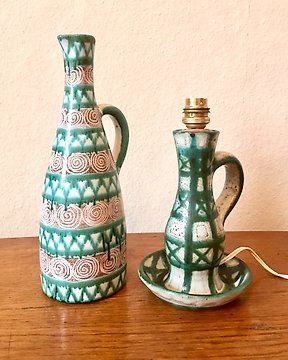
Robert Picault - Vallauris - Lamp and Pitcher (2) - Ceramic
No. 34310561

No. 34310561

A stunning two handled Henriot Quimper Breton Vase
Extensive floral handprinted design with grecian influences on the arms
Standing a majestic 23cm tall it is in excellent condition barring one small fleabite on the edge of one of the handles.
This beautiful treasure weighs over 2 kilos.
Quimper faience is produced in a factory near Quimper, in Brittany, France. Since 1708, Quimper faience ("faïence" in French) has been painted by hand, and production continues to this day. The "Faïenceries de Quimper" were established in "Locmaria", the historical faience quarter of the city of Quimper, near the center.
The Faïencerie d'Art Breton, newly created in 1994, was also established in Quimper, but outside the historical quarter "Locmaria". "Locmaria" now also houses a Quimper faience museum.
The pottery's design reflects a strong traditional Breton influence. One famous design which became typical for Quimper faience is the "petit breton", a naive representation of Breton man and/or woman in traditional Breton costume. The "petit breton" became popular around 1870 and is still today the main design.
Older Quimper faience items are strongly sought after by collectors worldwide.
How to buy on Catawiki
1. Discover something special
2. Place the top bid
3. Make a secure payment